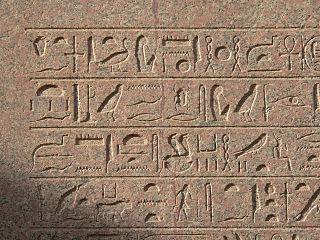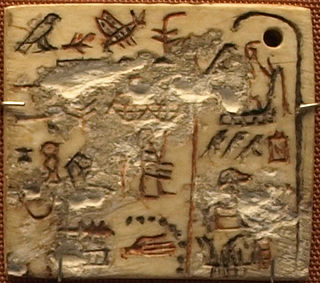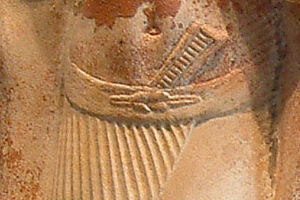
The ancient Egyptian Mast hieroglyph is one of the oldest language hieroglyphs from Ancient Egypt. It is used on a famous label of Pharaoh Den of the First dynasty, but forms part of the location hieroglyph: Emblem of the East.
The Foreleg of ox hieroglyph of ancient Egypt is an old hieroglyph; it even represented a nighttime constellation. It came to have many uses in ancient Egypt over three millennia.
The ancient Egyptian Papyrus stem hieroglyph is one of the oldest language hieroglyphs from Ancient Egypt. The papyrus stalk, was incorporated into designs of columns on buildings, also facades, and is also in the iconographic art portrayed in ancient Egyptian decorated scenes.
The ancient Egyptian Shuti, a two-feather adornment for crowns, is part of a series of hieroglyphs for "crowns"; usage as a hieroglyph is not as common as the actual crown represented in Egyptian art, and artworks.
The Egyptian hieroglyph for "black" in Gardiner's sign list is numbered I6. Its phonetic value is km. The Wörterbuch der ägyptischen Sprache lists no less than 24 different terms of km indicating 'black' such as black stone, metal, wood, hair, eyes, and animals, and in one instance applied to a person's name.

The ancient Egyptian Hill-country or "Foreign land" hieroglyph (𓈉) is a member of the sky, earth, and water hieroglyphs. A form of the hieroglyph in color, has a green line-(banding) at the base of the hieroglyph. The hieroglyph refers to the hills, and mountains, on both sides of the Nile River, and thus the green references the verdant black farming land adjacent to the river proper. It is coded N25 in Gardiner's sign list, and U+13209 in Unicode. It is determinative hieroglyph, simply conveying a meaning, and has no phonetic value.
The pectorals of ancient Egypt were a form of jewelry, often represented as a brooch. These were mostly worn by richer people and the pharaoh.

The ancient Egyptian Sky hieroglyph,, is Gardiner sign listed no. N1, within the Gardiner signs for sky, earth, and water.

The Egyptian hieroglyph Townsite-city-region is Gardiner sign listed no. O49 for the intersection of a town's streets. In some Egyptian hieroglyph books it is called a city plan.

The ancient Egyptian Pick hieroglyph, Gardiner sign listed nos. U17, U18 is a portrayal of a 'pick upon the side view of a block'; it is in the Gardiner subset for agriculture, crafts, and professions.

The ancient Egyptian Two Whips with Shen ring hieroglyph, Gardiner sign listed no. S23 is a portrayal of the Shen ring with two Egyptian flails-(Crook and flail); it is a member of the Gardiner subset for "crowns, dress, staves, etc".

In the Egyptian language, the single stair hieroglyph is used as a determinative.

The Egyptian hieroglyph ndj (nḏ) has the shape of a cross. It presumably depicts some type of tool such as a mill. It is often written alongside the nu "pot" hieroglyph (W24). It is used as an ideogram or determinative in the context of "grains", "grinding stone", "grind", "to rub out".

The ancient Egyptian Water-jugs-in-stand hieroglyph, is Gardiner sign listed no. W17, W18, within the Gardiner signs for vessels of stone and earthenware.

The ancient Egyptian Hand-with-droplets hieroglyph, Gardiner sign listed no. D46A is a portrayal of the hand, with droplet offerings. In the Old Kingdom usage it is found on ivory labels and slab stelas, presumably with the use of 'aroma' and unguents, or with incense. As the verb usage with 'libation', water or liquids are involved.

The ancient Egyptian knot hieroglyph, or girdle knot, Gardiner sign listed no. S24, portrays a reef knot. Besides its use as a hieroglyph, it has usage in statuary and reliefs. The knot hieroglyph is also an amulet, typically made of worked stone, or as jewellery elements.

The ancient Egyptian Arms-in-embrace hieroglyph, Gardiner sign listed no. D32 is a portrayal of the embracing human arms. The hieroglyph is in the large Gardiner sign list category of Parts of the Human Body.

The Three-Fox-Skins (hieroglyph) is Gardiner's sign listed no. F31, in the series of parts of animals. It consists of 3-fox skins tied at one end, and hanging, creating flowing skins.

The Land, irrigated hieroglyph represents "district, nome". It is a determinative in the name of provinces and regions in the noun ḥsp, for "garden", "vegetable garden", and "orchard".

The Hippopotamus (hieroglyph) is Gardiner sign listed no. E25, in the category of mammals. It is used in Egyptian hieroglyphs as a determinative in words designating the animal, in Egyptian as db, and kh3b.














